On Saturday Kendje, my boss (kind of the Galina Petrovna of The London School, for you AH folks) took me and Austin (the other new teacher) to Burana Tower with some of her friends and family. This is apparently something they do with all new teachers, and it was really a wonderful trip. The weather on Saturday was still warm, sunny and spring-like, with clear blue skies – excellent for photography.
We drove out of Bishkek around 11:00 in the morning, and began our trek eastward along what was once a branch of the Silk Road. Along the way, we drove through many small towns and villages. Every tiny town and village along the way had a brand new mosque, concrete, topped with a shiny steel cupola. We were told that these new mosques were constructed by Saudi Arabians, in an attempt to attract more Kyrgyz to the Muslim faith. Apparently, while the northern part of Kyrgyzstan is predominantly Muslim, they tend not to be overly serious about their faith. (Think about Christians you know go to church only on Christmas and Easter, but otherwise don’t think about it too much. The Islam of northern Kyrgyzstan is somewhat analogous.) In Bishkek, you see headscarves periodically, but they’re nowhere near as common as you might expect. Driving through these small villages on the way to Burana Tower, however, headscarves appeared to be substantially more common. We were also told that many of these mosques preach a fanatical Islam, espousing hatred of not only the West, but of all non-Muslims. I must admit that it made me think of the man in Waycross who invited me to attend a lecture on why the Bible says Muslims are evil. Yes, ladies and gentlemen, fanatics are everywhere.
We also learned that one of the small villages on the way to the city of Tokmok (either Kant or Ivanovka, I don’t remember) is home to a Russian air force base. This is especially interesting when you realize that the nearby village of Manas, home to the Bishkek airport, is also the location of an American air force base! (In fact, when you fly into Bishkek, the first thing you see – before you even see the buildings of the Manas Airport – is a long row of USAF fighter jets and transport planes.) I find it absolutely fascinating and rather mind boggling that here in Kyrgyzstan, not many kilometers from each other, sit both Russian and American air force bases. When I was asked why they were here, I was told the following: In 2000 (this was the date I was told, I haven’t confirmed it or anything) there were terrorist attacks in southern Kyrgyzstan. As a result, the Kyrgyz government invited the Russians and the Americans to set up bases on their territory to provide protection against terrorism. I’m not sure if this “protection” comes merely in the form of a deterrent, or if the Americans and/or Russians are actually involved in trying to root out terrorism here in Kyrgyzstan. I’ll have to try and find out more.
But moving on to Burana Tower... When we reached the city of Tokmok, we turned northward, and drove down a succession of narrow, winding roads until we reached the Burana Tower.

My first view of the tower...
Burana Tower, located about an hour east of Bishkek near the city of Tokmok, is all that remains of the ancient city of Balasagyn, once the thriving capital of the Karakhanid Empire. Apparently, at its height, the city manufactured exquisite glass and ceramics, had an elaborate city-wide irrigation/plumbing/sewer system built with fired-clay pipes, was home to scholars, poets and numerous religions (although in its later years it became a Muslim city), it was home to fierce warriors – male and female – and it was a major stop on one of the Silk Road routes (from the Torugart Pass out of China, past Lake Issyk-Kul through what is now Bishkek before heading further westward. Numerous spectacular archaeological finds have been uncovered at the site, although unfortunately, most were taken to museums in Russia during the time of the Soviet Union. The small museum which remains on the site houses only small fragments of artifacts, which are interesting, although somewhat depressing. Apparently, the entire site has yet to be excavated. There is a large hill, under which (supposedly) are the remains of an ancient mosque. However, there is no money for excavations.
When we arrived at the tower, our first item of business was to break out the food. We had a lovely picnic of hot tea, bread, pastries, cheese, sausage and hardboiled eggs. While we ate, a man rode by on a horse, and another drove past on a cart pulled by a donkey. In fact, while on our way to the tower, I saw many people using both such methods of transport.
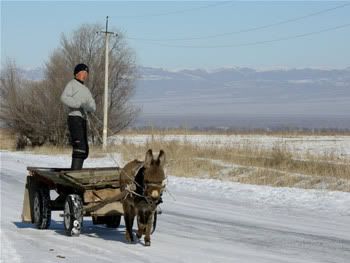

By the time we were ready to explore the tower, a marshrutka stuffed with a group schoolboys on an excursion had arrived. While they all immediately ran to climb the tower, we explored the museum and the surrounding grounds.

This picture hangs inside the museum, and shows the tower in the early-1920s, before its restoration in 1927.
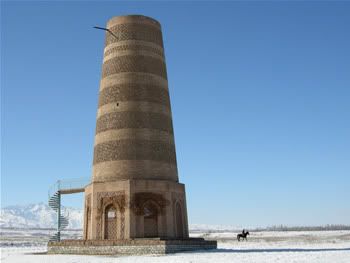
This is how the tower appears today.
The grounds surrounding the tower are filled with balbals, stone monuments to fallen warriors of ages past, and to ancient gods and goddesses.

I have no official explanation for what it's, um, doing...

This one looks quite snooty...

...meanwhile this one looks all fat and happy!
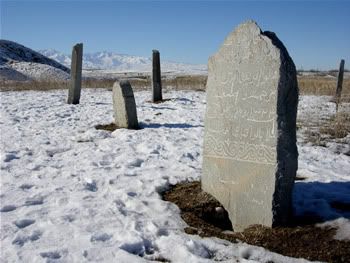
One of the few monuments with ancient script
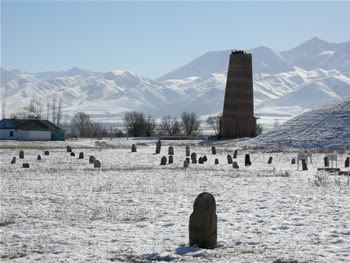
Burana Tower, as seen from across the balbal garden

The Burana Tower museum and caretaker's house

There is also a large collection of ancient heiroglyphs
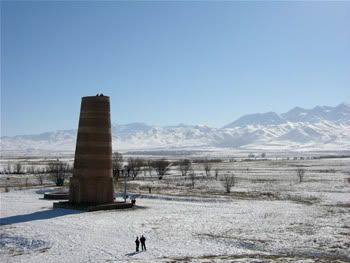
This photo was taken from atop the hill under which allegedly rest the remains of an unexcavated ancient mosque
Finally, the school kids cleared out, and we took our turn climbing to the top of Burana Tower. (The tower itself served both as a military watch tower for the town of Belasagyn and as a minaret for a nearby mosque.)
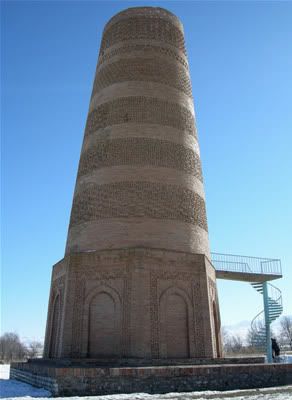
From the base of the tower

The winding staircase inside the tower was incredibly narrow and steep. The only light which illuminated it came from the camera's flash - and my headlamp, which I brought at the advice of the students. It put me in mind of the endless stair that Frodo, Sam and Gollum must ascend to enter Mordor. Luckily, this emerged somewhere much more pleasant!
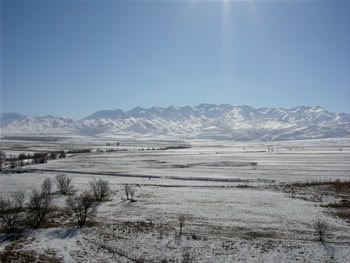
The view from the top was stunning!
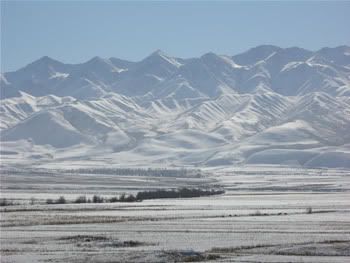
A close-up of the distant Tien Shan mountains
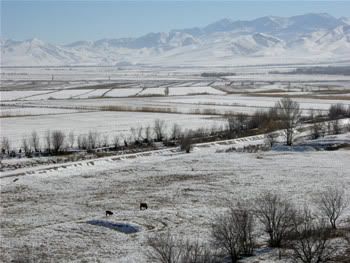
More view, with cows grazing below
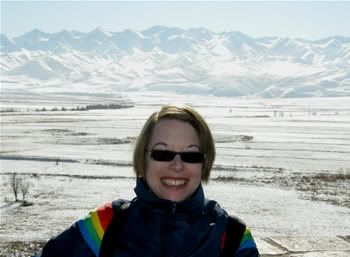
Me, atop Burana Tower.
We were lucky that we traveled to Burana when we did; today the skies are grey and dreary and winter seems to have returned.
We drove out of Bishkek around 11:00 in the morning, and began our trek eastward along what was once a branch of the Silk Road. Along the way, we drove through many small towns and villages. Every tiny town and village along the way had a brand new mosque, concrete, topped with a shiny steel cupola. We were told that these new mosques were constructed by Saudi Arabians, in an attempt to attract more Kyrgyz to the Muslim faith. Apparently, while the northern part of Kyrgyzstan is predominantly Muslim, they tend not to be overly serious about their faith. (Think about Christians you know go to church only on Christmas and Easter, but otherwise don’t think about it too much. The Islam of northern Kyrgyzstan is somewhat analogous.) In Bishkek, you see headscarves periodically, but they’re nowhere near as common as you might expect. Driving through these small villages on the way to Burana Tower, however, headscarves appeared to be substantially more common. We were also told that many of these mosques preach a fanatical Islam, espousing hatred of not only the West, but of all non-Muslims. I must admit that it made me think of the man in Waycross who invited me to attend a lecture on why the Bible says Muslims are evil. Yes, ladies and gentlemen, fanatics are everywhere.
We also learned that one of the small villages on the way to the city of Tokmok (either Kant or Ivanovka, I don’t remember) is home to a Russian air force base. This is especially interesting when you realize that the nearby village of Manas, home to the Bishkek airport, is also the location of an American air force base! (In fact, when you fly into Bishkek, the first thing you see – before you even see the buildings of the Manas Airport – is a long row of USAF fighter jets and transport planes.) I find it absolutely fascinating and rather mind boggling that here in Kyrgyzstan, not many kilometers from each other, sit both Russian and American air force bases. When I was asked why they were here, I was told the following: In 2000 (this was the date I was told, I haven’t confirmed it or anything) there were terrorist attacks in southern Kyrgyzstan. As a result, the Kyrgyz government invited the Russians and the Americans to set up bases on their territory to provide protection against terrorism. I’m not sure if this “protection” comes merely in the form of a deterrent, or if the Americans and/or Russians are actually involved in trying to root out terrorism here in Kyrgyzstan. I’ll have to try and find out more.
But moving on to Burana Tower... When we reached the city of Tokmok, we turned northward, and drove down a succession of narrow, winding roads until we reached the Burana Tower.

My first view of the tower...
Burana Tower, located about an hour east of Bishkek near the city of Tokmok, is all that remains of the ancient city of Balasagyn, once the thriving capital of the Karakhanid Empire. Apparently, at its height, the city manufactured exquisite glass and ceramics, had an elaborate city-wide irrigation/plumbing/sewer system built with fired-clay pipes, was home to scholars, poets and numerous religions (although in its later years it became a Muslim city), it was home to fierce warriors – male and female – and it was a major stop on one of the Silk Road routes (from the Torugart Pass out of China, past Lake Issyk-Kul through what is now Bishkek before heading further westward. Numerous spectacular archaeological finds have been uncovered at the site, although unfortunately, most were taken to museums in Russia during the time of the Soviet Union. The small museum which remains on the site houses only small fragments of artifacts, which are interesting, although somewhat depressing. Apparently, the entire site has yet to be excavated. There is a large hill, under which (supposedly) are the remains of an ancient mosque. However, there is no money for excavations.
When we arrived at the tower, our first item of business was to break out the food. We had a lovely picnic of hot tea, bread, pastries, cheese, sausage and hardboiled eggs. While we ate, a man rode by on a horse, and another drove past on a cart pulled by a donkey. In fact, while on our way to the tower, I saw many people using both such methods of transport.


By the time we were ready to explore the tower, a marshrutka stuffed with a group schoolboys on an excursion had arrived. While they all immediately ran to climb the tower, we explored the museum and the surrounding grounds.

This picture hangs inside the museum, and shows the tower in the early-1920s, before its restoration in 1927.

This is how the tower appears today.
The grounds surrounding the tower are filled with balbals, stone monuments to fallen warriors of ages past, and to ancient gods and goddesses.

I have no official explanation for what it's, um, doing...

This one looks quite snooty...

...meanwhile this one looks all fat and happy!

One of the few monuments with ancient script

Burana Tower, as seen from across the balbal garden

The Burana Tower museum and caretaker's house

There is also a large collection of ancient heiroglyphs

This photo was taken from atop the hill under which allegedly rest the remains of an unexcavated ancient mosque
Finally, the school kids cleared out, and we took our turn climbing to the top of Burana Tower. (The tower itself served both as a military watch tower for the town of Belasagyn and as a minaret for a nearby mosque.)

From the base of the tower

The winding staircase inside the tower was incredibly narrow and steep. The only light which illuminated it came from the camera's flash - and my headlamp, which I brought at the advice of the students. It put me in mind of the endless stair that Frodo, Sam and Gollum must ascend to enter Mordor. Luckily, this emerged somewhere much more pleasant!

The view from the top was stunning!

A close-up of the distant Tien Shan mountains

More view, with cows grazing below

Me, atop Burana Tower.
We were lucky that we traveled to Burana when we did; today the skies are grey and dreary and winter seems to have returned.

3 comments:
The picture of teh staircase is awesome.
The Russian base is in Kant, which happens to be the city where our group traning was based out of. We were told that the Russians set up their base after the Americans set up a base in attempt to 'balance each other out.' Regardless, I agree that it *is* pretty disconcerning.
Thanks, thanks and thanks! :-0)
Post a Comment